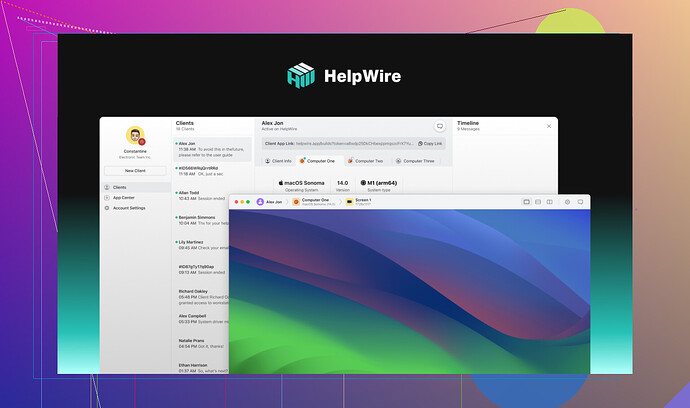I’m looking for an alternative to TeamViewer for remote desktop on Windows. I’ve had connection issues with TeamViewer lately, and I’m hoping there’s a reliable option that works well for personal or occasional use. Suggestions?
If you’re searching for a reliable and uncomplicated solution, HelpWire might just be the tool you’re looking for. It’s entirely free and can be seamlessly utilized on Mac, Windows, and Linux systems. Forget about intrusive ads or lengthy setup processes—HelpWire is built for simplicity. All you need to do is install and connect, making it an effortlessly straightforward choice.
Unlike alternatives like TeamViewer that might impose peculiar limitations, time restrictions, or complex configurations, HelpWire is unrestricted and user-friendly. One of its standout features is its ability to operate flawlessly even if firewalls are in place, eliminating the need for tricky network adjustments.
In essence, it promises to deliver exactly what you’re after—without overwhelming costs or complications. It’s definitely a solution worth trying if simplicity, efficiency, and cost-effectiveness are high on your priority list.
I’ve been in your shoes dealing with TeamViewer issues, and while I see @mikeappsreviewer vouching for HelpWire (which honestly does sound interesting), I want to throw a few more suggestions into the hat. First up, have you tried AnyDesk? It’s lightweight, fast, and works well for personal use. The free version is solid, and I rarely deal with connection drops unless my own Wi-Fi is having its usual tantrums. Plus, it handles low bandwidth scenarios like a champ.
That being said, a lot of people overlook Chrome Remote Desktop. It’s not the fanciest tool out there, but it gets the job done if you’re looking for something simple and free. It’s ridiculously easy to set up too—basically a browser extension. Of course, the catch is it’s tied to Google accounts, but hey, for occasional use, it’s not bad.
Now, regarding streamlined remote desktop solutions like HelpWire, I’ll admit bypassing firewalls effortlessly is a pretty sweet promise. I haven’t tested it myself, but if connection reliability and avoiding frustrating setup hurdles are priorities for you, it’s worth giving it a shot.
The only caveat with some of these choices is ensuring you’re okay with the reduced feature set compared to TeamViewer’s robust offering. But for personal or basic needs, these tools cover plenty of ground.
If you’re experiencing TeamViewer woes, let’s get straight to the point. There are a ton of options out there that might suit your needs better depending on what you’re after. Since @mikeappsreviewer already gave a shoutout to HelpWire (which seems like a sweet and straightforward tool), and @espritlibre brought up AnyDesk and Chrome Remote Desktop (solid picks, tbh), let me add a couple of my thoughts.
First, Windows Remote Desktop Protocol (RDP)—it’s already built into Windows. If you’re on a Windows Pro or Enterprise version, you already have remote access capabilities at no extra cost. Sure, setting it up might take a bit of tinkering compared to plug-and-play tools like HelpWire, but once it’s running, it’s fast and secure over a LAN or VPN. The downside? It’s not super friendly for personal use across random networks and can be limited when traveling.
Now for something lighter—RustDesk. Think of it like an open-source cousin to AnyDesk. No installation required, and you can self-host the server if you value privacy. The UI might not win design awards, but it’s functional and free, which is great for occasional use.
To balance things out, let me wave a tiny flag of caution for browser-based tools like Chrome Remote Desktop. They’re convenient, no doubt, but let’s not pretend they can go toe-to-toe in features or reliability when compared with stand-alone desktop apps. For straightforward access, they work; for anything remotely complex, they tap out early.
Last plug—I think HelpWire might be surprisingly simple if you’re sick of fighting firewalls and just want something to ‘install-connect-and-go’. It seems super no-fuss, and free TeamViewer replacements like this could hit the sweet spot if you’re not looking for crazy advanced functionalities. Just keep in mind that you might miss some deeper options TeamViewer had.
At the end of the day, figure out if you’re looking for something free, lightweight, or packed with features—and test a couple of these. Let us know what works for you.

